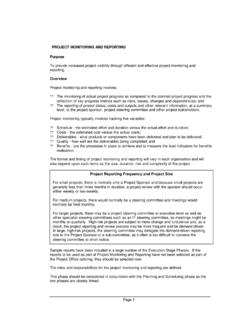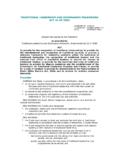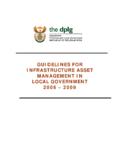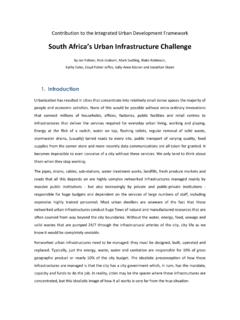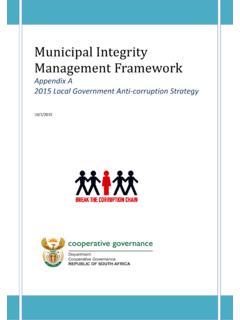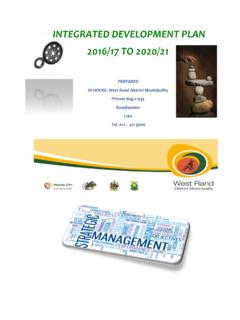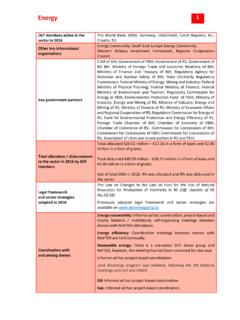Transcription of MEDIUM-TERM STRATEGIC FRAMEWORK (MTSF) …
1 THE PRESIDENCYREPUBLIC OF SOUTH AFRICADEPARTMENT: PLANNING, MONITORING AND EVALUATION2014 - 2019 MEDIUM-TERM STRATEGIC FRAMEWORK (MTSF) 2 Table of Contents .. 4 The purpose of the mtsf .. 4 How the mtsf was developed .. 5 focus for the next five years .. Radical economic transformation .. 6 Improving service delivery .. 11 and local economic context .. of the mtsf .. implementation of the mtsf .. of priorities and actions for the next five years .. Quality basic education .. 16 A long and healthy life for all South Africans .. 17 All people in South Africa are and feel safe .. 19 Decent employment through inclusive growth .. 20 A skilled and capable workforce to support an inclusive growth path .. 22 An efficient, competitive and responsive economic infrastructure network .. 23 Vibrant, equitable, sustainable rural communities contributing towards food security for all.
2 25 Sustainable human settlements and improved quality of household life .. 26 Responsive, accountable, effective and efficient local 27 Protect and enhance our environmental assets and natural resources .. 28 Create a better South Africa and contribute to a better Africa and a better world .. 29 3 An efficient, effective and development-oriented public service .. 31 A comprehensive, responsive and sustainable social protection system .. 33 A diverse, socially cohesive society with a common national identity .. 34 7. Appendices .. 36 4 1. Introduction Background South Africa has begun a new phase of its democratic transition. The electoral mandate of the fifth democratic government is to deepen transformation and implement the National Development Plan (NDP). It is to accelerate growth, create decent work and promote investment in a competitive economy. In giving effect to this mandate, we continue to be guided by our Constitutional commitment to improve the quality of life of all citizens and free the potential of each person.
3 Over the last 20 years, the first phase of our democratic transition, the foundations have been laid for a non-racial, non-sexist, united and prosperous South Africa, and for a society based on fundamental human rights, equality and unity in diversity. Our people s dignity has been restored. Non-racial majority rule based on one-person, one-vote has brought about government based on the will of the people. At the end of the last administration (2009-2014), the Presidency published a Twenty Year Review, outlining progress made since 1994 and identifying the challenges that still need to be overcome. Today, South Africa is a better place in which to live than it was in 1994. Political and social rights are protected, and the lives of millions of South Africans have improved, through new laws, better public services, expansion of economic opportunities and improved living conditions.
4 However, the challenges still facing our country are immense. As the Twenty Year Review and the National Planning Commission s 2011 Diagnostic Report highlight poverty, inequality and unemployment continue to negatively affect the lives of many people. Too few people have work, investment is too slow and education lags behind our requirements. The weak state of the economy impedes our efforts to reach our development goals. The second phase of our democratic transition calls for bold and decisive steps to place the economy on a qualitatively different path that eliminates poverty, creates jobs and sustainable livelihoods, and substantially reduces inequality. This requires radical economic transformation and a sustained focus on addressing the uneven quality of service delivery. The purpose of the mtsf This medium Term STRATEGIC FRAMEWORK ( mtsf ) is Government s STRATEGIC plan for the 2014-2019 electoral term.
5 It reflects the commitments made in the election manifesto of the governing party, including the commitment to implement the NDP. The mtsf sets out the actions Government will take and targets to be achieved. It also provides a FRAMEWORK for the other plans of national, provincial and local government. The mtsf highlights Government s support for a competitive economy, creation of decent work opportunities and encouragement of investment. This is the first mtsf to follow the adoption of the NDP in September 2012. The introduction of a long-term plan brings greater coherence and continuity to the planning system and means that the mtsf now becomes a 5 five year building block towards the achievement of the vision and goals of the country s long-term plan. In the words of President Zuma: The Plan has been adopted as a National Plan for the whole country. It is our roadmap for the next 20 years.
6 All the work we do in government is now part of the comprehensive National Development Plan, including all operational plans, be they social, economic or political. The aim of the mtsf is to ensure policy coherence, alignment and coordination across government plans as well as alignment with budgeting processes. Performance agreements between the President and each Minister will reflect the relevant actions, indicators and targets set out in this mtsf . Within the NDP vision, key policy instruments developed in the previous term will continue to drive government s policy agenda. These include the New Growth Path, which sets the trajectory of economic development, the National Infrastructure Plan, which guides the roll-out of infrastructure to improve people s lives and enable economic growth, and the Industrial Policy Action Plan, which focuses on promoting investment and competitiveness in leading sectors and industries.
7 Government will also take forward key social development initiatives, including social security and retirement reform, National Health Insurance, improvements in basic education and expansion of technical and vocational education. How the mtsf was developed Following the adoption of the NDP, Cabinet decided in 2013 that the 2014-2019 mtsf should form the first five-year implementation phase of the NDP and mandated work to begin on aligning the plans of national and provincial departments, municipalities and public entities with the NDP vision and goals. Since the May 2014 elections, the mtsf has been aligned to the national governing party s election manifesto. The mtsf is the result of an intensive planning process involving all three spheres of government. It provides a FRAMEWORK for prioritising and sequencing government programmes and development initiatives for the next five years.
8 2. STRATEGIC focus for the next five years The NDP provides the FRAMEWORK for achieving the radical socio-economic agenda set out in the governing party s election manifesto. It recognises the need for a capable and developmental state, a thriving business sector and strong civil society institutions with shared and complementary responsibilities. It identifies decent work, education and the capacity of the state as particularly important priorities. It also highlights the need to improve the quality of administration of many government activities. 6 The 2014-2019 electoral mandate focuses on the following priorities: Radical economic transformation, rapid economic growth and job creation Rural development, land and agrarian reform and food security Ensuring access to adequate human settlements and quality basic services Improving the quality of and expanding access to education and training Ensuring quality health care and social security for all citizens Fighting corruption and crime Contributing to a better Africa and a better world Social cohesion and nation building.
9 In its focus on these priorities, and their elaboration into fourteen key outcomes and associated activities and targets, the mtsf has two over-arching STRATEGIC themes radical economic transformation and improving service delivery. Radical economic transformation Government s programme of radical economic transformation is about placing the economy on a qualitatively different path that ensures more rapid, sustainable growth, higher investment, increased employment, reduced inequality and deracialisation of the economy. The NDP sets an annual growth target of above 5% by 2030 and emphasises measures to ensure that the benefits of growth are equitably shared. Achievement of economic transformation and inclusive growth will not result from a single intervention, but from a range of mutually supporting initiatives. In many cases, this does not require new strategies, but better implementation of existing ones.
10 The New Growth Path targets five million new jobs from 2010 to 2020. This target will require vigorous action to reduce concentration and diversify the economy, while ensuring adequate infrastructure, skills and appropriate regulatory frameworks. It also requires that the state promotes and supports new and innovative activities that can add value and generate employment on a large scale. We need to ensure growth in the core productive sectors of manufacturing, mining and agriculture and open new areas of economic growth such as the oceans economy, the green economy and shale gas. Small business needs to make a much larger contribution to growth. More rapid private sector investment is critical for higher growth, as the private sector accounts for 80% of production and employment. The NDP indicates that South Africa needs to increase its level of investment to at least 30% of GDP by 2030.
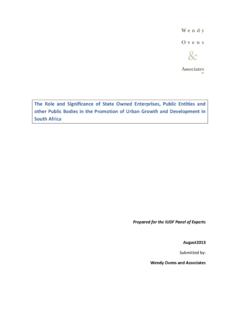
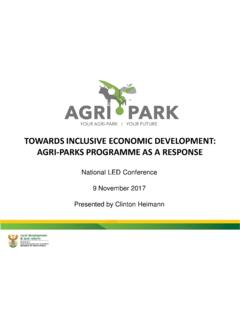
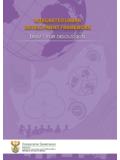
![Disaster Management Act [No. 57 of 2002]](/cache/preview/e/5/d/2/b/3/6/7/thumb-e5d2b36743b64ebe9204d7e874f734ad.jpg)
